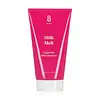What's inside
What's inside
 Key Ingredients
Key Ingredients

 Benefits
Benefits

 Concerns
Concerns

No concerns
 Ingredients Side-by-side
Ingredients Side-by-side

Water
Skin ConditioningCaprylic/Capric Triglyceride
MaskingGlycerin
HumectantSodium Laurylglucosides Hydroxypropylsulfonate
CleansingColloidal Oatmeal
AbsorbentMaltooligosyl Glucoside
Skin ConditioningSodium Cocoamphoacetate
CleansingHydrogenated Starch Hydrolysate
HumectantAvena Sativa Kernel Oil
Skin ConditioningLauryl Glucoside
CleansingXanthan Gum
EmulsifyingPropanediol
SolventSodium Cocoyl Glutamate
CleansingSodium Lauryl Glucose Carboxylate
CleansingBenzyl Alcohol
PerfumingLactic Acid
BufferingSodium Chloride
MaskingSodium Cocoyl Hydrolyzed Oat Protein
Skin ConditioningCaprylic Acid
CleansingXylitol
HumectantTetrasodium Glutamate Diacetate
Tocopherol
AntioxidantCocos Nucifera Fruit Extract
EmollientLeuconostoc/Radish Root Ferment Filtrate
AntimicrobialLactobacillus Ferment
Skin ConditioningAgastache Mexicana Flower/Leaf/Stem Extract
Skin ConditioningButylene Glycol
HumectantWater, Caprylic/Capric Triglyceride, Glycerin, Sodium Laurylglucosides Hydroxypropylsulfonate, Colloidal Oatmeal, Maltooligosyl Glucoside, Sodium Cocoamphoacetate, Hydrogenated Starch Hydrolysate, Avena Sativa Kernel Oil, Lauryl Glucoside, Xanthan Gum, Propanediol, Sodium Cocoyl Glutamate, Sodium Lauryl Glucose Carboxylate, Benzyl Alcohol, Lactic Acid, Sodium Chloride, Sodium Cocoyl Hydrolyzed Oat Protein, Caprylic Acid, Xylitol, Tetrasodium Glutamate Diacetate, Tocopherol, Cocos Nucifera Fruit Extract, Leuconostoc/Radish Root Ferment Filtrate, Lactobacillus Ferment, Agastache Mexicana Flower/Leaf/Stem Extract, Butylene Glycol
 Reviews
Reviews

Ingredients Explained
These ingredients are found in both products.
Ingredients higher up in an ingredient list are typically present in a larger amount.
Butylene Glycol (or BG) is used within cosmetic products for a few different reasons:
Overall, Butylene Glycol is a safe and well-rounded ingredient that works well with other ingredients.
Though this ingredient works well with most skin types, some people with sensitive skin may experience a reaction such as allergic rashes, closed comedones, or itchiness.
Learn more about Butylene GlycolGlycerin is already naturally found in your skin. It helps moisturize and protect your skin.
A study from 2016 found glycerin to be more effective as a humectant than AHAs and hyaluronic acid.
As a humectant, it helps the skin stay hydrated by pulling moisture to your skin. The low molecular weight of glycerin allows it to pull moisture into the deeper layers of your skin.
Hydrated skin improves your skin barrier; Your skin barrier helps protect against irritants and bacteria.
Glycerin has also been found to have antimicrobial and antiviral properties. Due to these properties, glycerin is often used in wound and burn treatments.
In cosmetics, glycerin is usually derived from plants such as soybean or palm. However, it can also be sourced from animals, such as tallow or animal fat.
This ingredient is organic, colorless, odorless, and non-toxic.
Glycerin is the name for this ingredient in American English. British English uses Glycerol/Glycerine.
Learn more about GlycerinLauryl Glucoside sugar- and lipid-based cleansing agent. It is created from glucose and lauryl alcohol.
This ingredient is a surfactant, making it easier to rinse oil, dirt, and other pollutants away.
A British study found lauryl glucoside to cause skin sensitivity for some people. We recommend speaking with a professional if you have concerns.
Other names for this ingredient include "Lauryl Polyglucose", "Lauryl glycoside", and "D-Glucopyranoside".
Learn more about Lauryl GlucosidePropanediol is an all-star ingredient. It softens, hydrates, and smooths the skin.
It’s often used to:
Propanediol is not likely to cause sensitivity and considered safe to use. It is derived from corn or petroleum with a clear color and no scent.
Learn more about PropanediolTocopherol (also known as Vitamin E) is a common antioxidant used to help protect the skin from free-radicals and strengthen the skin barrier. It's also fat soluble - this means our skin is great at absorbing it.
Vitamin E also helps keep your natural skin lipids healthy. Your lipid skin barrier naturally consists of lipids, ceramides, and fatty acids. Vitamin E offers extra protection for your skin’s lipid barrier, keeping your skin healthy and nourished.
Another benefit is a bit of UV protection. Vitamin E helps reduce the damage caused by UVB rays. (It should not replace your sunscreen). Combining it with Vitamin C can decrease sunburned cells and hyperpigmentation after UV exposure.
You might have noticed Vitamin E + C often paired together. This is because it is great at stabilizing Vitamin C. Using the two together helps increase the effectiveness of both ingredients.
There are often claims that Vitamin E can reduce/prevent scarring, but these claims haven't been confirmed by scientific research.
Learn more about TocopherolWater. It's the most common cosmetic ingredient of all. You'll usually see it at the top of ingredient lists, meaning that it makes up the largest part of the product.
So why is it so popular? Water most often acts as a solvent - this means that it helps dissolve other ingredients into the formulation.
You'll also recognize water as that liquid we all need to stay alive. If you see this, drink a glass of water. Stay hydrated!
Learn more about Water